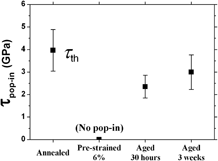Crossref Citations
This article has been cited by the following publications. This list is generated based on data provided by
Crossref.
Lee, Keunho
Park, Seong-Jun
Choi, Yong Seok
Kim, Se-Jong
Lee, Tae-Ho
Oh, Kyu Hwan
and
Han, Heung Nam
2013.
Dual-scale correlation of mechanical behavior in duplex low-density steel.
Scripta Materialia,
Vol. 69,
Issue. 8,
p.
618.
Laplanche, G.
Pfetzing-Micklich, J.
and
Eggeler, G.
2014.
Sudden stress-induced transformation events during nanoindentation of NiTi shape memory alloys.
Acta Materialia,
Vol. 78,
Issue. ,
p.
144.
Marukawa, Kenzaburo
and
Ohmura, Takahito
2014.
Dislocation Theories Applied to the Elucidation of Mechanisms of Metal Strengthening.
Tetsu-to-Hagane,
Vol. 100,
Issue. 9,
p.
1076.
Ahn, Tae-Hong
Lee, Sung Bo
Park, Kyung-Tae
Oh, Kyu Hwan
and
Han, Heung Nam
2014.
Strain-induced ε-martensite transformation during nanoindentation of high-nitrogen steel.
Materials Science and Engineering: A,
Vol. 598,
Issue. ,
p.
56.
Han, Do Kyeong
Kim, Yong Min
Han, Heung Nam
Bhadeshia, H.K.D.H.
and
Suh, Dong-Woo
2014.
Hydrogen and aluminium in high-manganese twinning-induced plasticity steel.
Scripta Materialia,
Vol. 80,
Issue. ,
p.
9.
He, B.B.
Liang, Z.Y.
and
Huang, M.X.
2018.
Nanoindentation investigation on the initiation of yield point phenomenon in a medium Mn steel.
Scripta Materialia,
Vol. 150,
Issue. ,
p.
134.
Shen, Zhengyan
Wang, Bilei
Liang, Gaofei
Zhang, Yunhu
Han, Ke
and
Song, Changjiang
2018.
Grain Boundary Pop-in, Yield Point Phenomenon and Carbon Segregation in Aged Low Carbon Steel.
ISIJ International,
Vol. 58,
Issue. 2,
p.
373.
Khosravani, Ali
Morsdorf, Lutz
Tasan, Cemal Cem
and
Kalidindi, Surya R.
2018.
Multiresolution mechanical characterization of hierarchical materials: Spherical nanoindentation on martensitic Fe-Ni-C steels.
Acta Materialia,
Vol. 153,
Issue. ,
p.
257.
Rezayat, H.
Ghassemi-Armaki, H.
Bhat, S. P.
Sriram, S.
and
Babu, S. S.
2019.
Constitutive properties and plastic instabilities in the heat-affected zones of advanced high-strength steel spot welds.
Journal of Materials Science,
Vol. 54,
Issue. 7,
p.
5825.
Park, Sun-Young
Kim, Young-Cheon
Ruoff, Rodney S.
and
Kim, Ju-Young
2019.
Incipient plasticity and fully plastic contact behavior of copper coated with a graphene layer.
APL Materials,
Vol. 7,
Issue. 3,
Pöhl, Fabian
2019.
Pop-in behavior and elastic-to-plastic transition of polycrystalline pure iron during sharp nanoindentation.
Scientific Reports,
Vol. 9,
Issue. 1,
Lee, Jaeeun
Kim, Hwangsun
Park, Seoung-Jun
Moon, Joonoh
and
Han, Heung Nam
2019.
Correlation between macroscale tensile properties and small-scale intrinsic mechanical behavior of Mo-added Fe–Mn–Al–C lightweight steels.
Materials Science and Engineering: A,
Vol. 768,
Issue. ,
p.
138460.
Valdes-Tabernero, M.A.
Petrov, R.H.
Monclus, M.A.
Molina-Aldareguia, J.M.
and
Sabirov, I.
2019.
The effect of soaking time after ultrafast heating on the microstructure and mechanical behavior of a low carbon steel.
Materials Science and Engineering: A,
Vol. 765,
Issue. ,
p.
138276.
Khosravani, Ali
Caliendo, Charles M.
and
Kalidindi, Surya R.
2019.
New Insights into the Microstructural Changes During the Processing of Dual-Phase Steels from Multiresolution Spherical Indentation Stress–Strain Protocols.
Metals,
Vol. 10,
Issue. 1,
p.
18.
Oh, Yeonju
Kwak, Nojun
Lee, Keunho
Ko, Won-Seok
and
Han, Heung Nam
2019.
Ductility enhancement of tungsten after plastic deformation.
Journal of Alloys and Compounds,
Vol. 787,
Issue. ,
p.
801.
Jo, Haeju
Kang, Moonseok
Park, Geon-Woo
Kim, Byung-Jun
Choi, Chang Yong
Park, Hee Sang
Shin, Sunmi
Lee, Wookjin
Ahn, Yong-Sik
and
Jeon, Jong Bae
2020.
Effects of Cooling Rate during Quenching and Tempering Conditions on Microstructures and Mechanical Properties of Carbon Steel Flange.
Materials,
Vol. 13,
Issue. 18,
p.
4186.
Wang, Yanxu
Tomota, Yo
Ohmura, Takahito
Gong, Wu
Harjo, Stefanus
and
Tanaka, Masahiko
2020.
Continuous and discontinuous yielding behaviors in ferrite-cementite steels.
Acta Materialia,
Vol. 196,
Issue. ,
p.
565.
Rowe, Russell A.
Tajyar, Ali
Munther, Michael
Johanns, Kurt E.
Allison, Paul G.
Momeni, Kasra
and
Davami, Keivan
2021.
Nanoscale serration characteristics of additively manufactured superalloys.
Journal of Alloys and Compounds,
Vol. 854,
Issue. ,
p.
156723.
Adachi, Nozomu
Suzuki, Takuya
Ohmura, Takahito
and
Todaka, Yoshikazu
2021.
Analytical approach for pop-in and post-pop-in deformation behavior during nanoindentation: effect of solute Si in interstitial free steel.
Journal of Materials Research,
Vol. 36,
Issue. 12,
p.
2571.
2021.
Testing of the Plastic Deformation of Metals.
p.
192.



